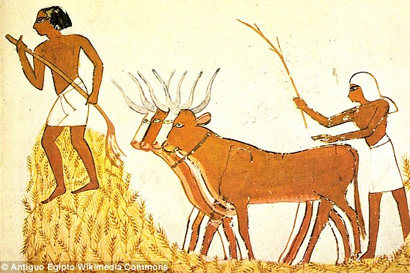Humans began altering natural world 6,000 years ago
Human population had gotten dense enough to irreversibly alter the interactions among plants and animals
December 16, 2015
Scientists have found an abrupt change about 6,000 years ago in how terrestrial plant and animal species coexisted, right about the time human populations were ballooning and agriculture was spreading around the world.

Egyptian farmers in the Neolithic period 5,000-6,000 years ago.
The findings suggest that human activity had reached a tipping point where hunting and farming were impacting the natural world in irreversible ways — changes that have continued to increase to this day.
The researchers, including UC Berkeley’s Cindy Looy, an assistant professor of integrative biology, will report their findings in the Dec. 17 issue of the journal Nature.
The scientists looked at fossil data on how species coexisted over the past 307 million years, specifically how often a particular pair of plant or animal species is found within the same community. Out of all possible combinations of two species in a certain region and time interval, the proportion of pairs of species that co-occurred remained relatively stable until 6,000 years ago. At that time, the chances of co-occurrence dropped significantly, suggesting that humans were creating some barrier to the dispersal of plants or animals.
“This tells us that humans have been having a massive effect on the environment for a very long time,” said lead author S. Kathleen Lyons, a paleobiologist in the Evolution of Terrestrial Ecosystems (ETE) program at the Smithsonian Institution’s National Museum of Natural History in Washington, D.C.
Analyses of modern communities of plants and animals have found that for most pairs of species, the presence of one species within a community does not influence whether the other is present or absent. For pairs where there is an association, most occur within the same community less frequently than expected, suggesting some influence keeps them apart.
But when Lyons, Looy and their colleagues investigated the composition of ancient communities using fossil data, they found exactly the opposite. Their analysis showed that from 307 million years ago, the time known as the Carboniferous period, to about 6,000 years ago, in the Holocene epoch, there was a pattern of pairs of species occurring together within communities rather than being segregated.
“The proportion of co-occurring species pairs was relatively stable from the late Paleozoic until 6,000 years ago, even during periods of major climate change and mass extinction and despite the appearance of many new players in the terrestrial ecosystems, such as mammals and flowering plants,” Looy said. “The decline of coupled species pairs in the Holocene also cannot be explained by the transition from the last glacial to the current interglacial at the end of the Pleistocene, as this happened too early. Instead, it is more likely caused by an increase in human population size and the resulting land use and agriculture.”
Around the time co-occurrence patterns changed, humans were becoming increasingly dependent on agriculture, a cultural shift that physically altered the environment and would have introduced artificial barriers to dispersal never seen before. Even at low levels of agriculture and other human impacts, there was a detectable shift in co-occurrence structure, indicating that species were not able to migrate as easily as they did for the previous 300 million years.
For more details about the study, see this story on the Smithsonian’s website.
See also: